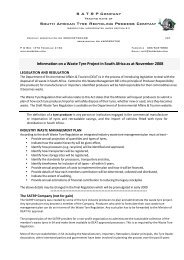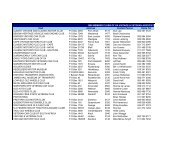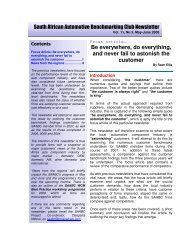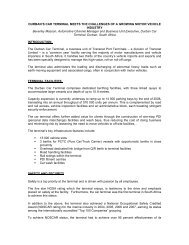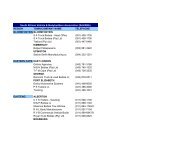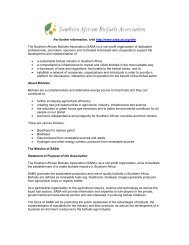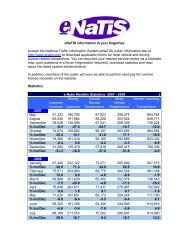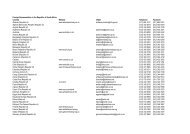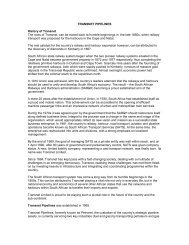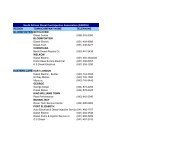Toyota South Africa Sustainability Report 2008 - Automotiveonline ...
Toyota South Africa Sustainability Report 2008 - Automotiveonline ...
Toyota South Africa Sustainability Report 2008 - Automotiveonline ...
Create successful ePaper yourself
Turn your PDF publications into a flip-book with our unique Google optimized e-Paper software.
<strong>Sustainability</strong> <strong>Report</strong>_14-10-<strong>2008</strong>:Layout 1 10/14/08 2:44 PM Page 13<br />
Reducing CO 2 emissions and energy use has been on our environmental agenda and is<br />
a focal point in the 4 th <strong>Toyota</strong> Environmental Action Plan. Our primary sources of energy<br />
are electricity and gas, used for heating.<br />
With the commissioning and slow ramp up of Paint Line 3, and the change to double<br />
shifts, energy consumption and CO 2 emissions increased in the FY’06 period, although<br />
not as much as had been anticipated.<br />
ENERGY CONSUMED PER UNIT (GAS AND ELECTRICITY): PRODUCTION<br />
CO 2 EMISSIONS TOTAL: PRODUCTION<br />
200,000<br />
Tons<br />
100,000<br />
0<br />
FY’04 FY’05 FY’06 FY’07<br />
LP Gas 0 0 5,702 18,252<br />
Methane gas 17,338 17,828 17,700 6,365<br />
Electricity 109,232 129,905 166,419 153,990<br />
GJ/unit<br />
15<br />
10<br />
5<br />
CO 2 EMISSIONS PER UNIT: PRODUCTION<br />
0<br />
FY’04 FY’05 FY’06 FY’07<br />
Actual 6.31 5.52 6.61 6.65<br />
With the electricity service provider Eskom requesting a reduction in power usage of 10%<br />
over all business sectors, our manufacturing plant was one of the first to install solar<br />
panels. The renewable energy project began in<br />
2006 with the installation of 44 x 2,5m 2 panels<br />
in the Chassis Plant and in FY’05 we reported on<br />
the CO 2 savings generated. Solar energy is used<br />
to heat water for canteens and ablutions.<br />
The second phase was completed in June 2007<br />
when 150 panels were installed in the Weld<br />
Plant. In the third phase of this project, a further<br />
120 panels will be installed in other facilities.<br />
While the project has cost R3.5-million, savings<br />
of R95,000 per month on energy costs are<br />
expected when the project is completed.<br />
Tons/Unit<br />
1.30<br />
1.20<br />
1.10<br />
1.00<br />
0.90<br />
FY’04 FY’05 FY’06 FY’07<br />
Actual 1.12 1.08 1.25 1.13<br />
The installation of solar panels has enabled us to reduce carbon dioxide emissions by<br />
approximately 1,350 tons per annum compared to electricity usage.<br />
Other energy efficiency improvement and energy reduction changes have been made<br />
through for example, changing of light bulb installations. A study established that 42%<br />
of production energy is consumed during non-production time and this allows<br />
considerable room for improvement. Under the slogan “No Work-No Watt” focus is on<br />
the shut-down of energy consuming equipment during non-production hours. Since<br />
this program started, energy during non-production hours has decreased to 36% of<br />
normal production energy use. In May 2007, energy efficient light bulbs were issued to<br />
every employee.This equals a 71 kilowatt saving per person per year, which for the whole<br />
of <strong>Toyota</strong> <strong>South</strong> <strong>Africa</strong> equates to approximately 715 megawatts/year total saving.<br />
<strong>Sustainability</strong> <strong>Report</strong> <strong>2008</strong> 13



